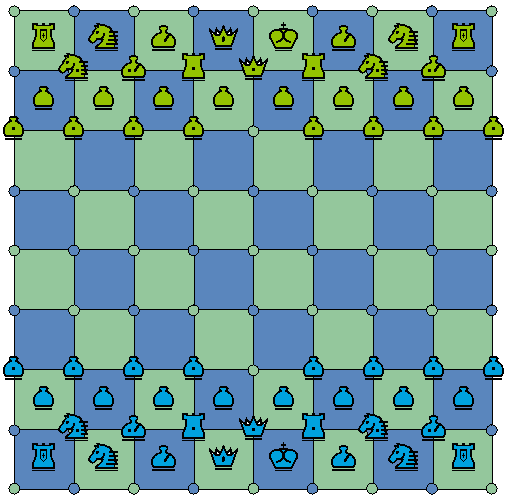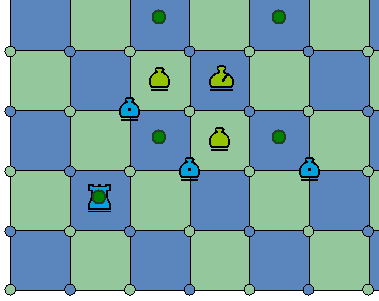InterGrid Chess
The goal of this game was to utilize both the 64 squares, and the 81 intersections of a standard chessboard, utilizing standard chess pieces, and keeping the rules as simple as possible.Equipment Required
- 1 Chess set with a fairly large squares and smaller pieces
- An extra set of (preferably smaller) chess pieces
Terminology
- Point-piece
- a piece that moves on the intersections of the squares.
- Square-piece
- a piece that moves on the squares themselves.
Initial Array

For textual version, look here.
Turn Sequence
Each turn, a player moves a square-piece, followed by an (optional) point-piece move. The player's King may remain in check following the square-piece move, as long as the point-piece move removes the check.Movement
All the pieces move as in
orthodox chess. For point-pieces, think of the intersections as squares.

If two square-pieces are on orthogonally adjacent squares, they form a barrier which blocks a point-piece. Similarly, if two point-pieces are on orthogonally adjacent intersections, they form a barrier which blocks a square-piece. These barriers only block orthogonal movement.
In the diagram to the right, the Rook in the lower left corner may only move to the squares marked with a green circle.

A point-piece moving diagonally is blocked if there is a square-piece on the square it is moving over. A square-piece is similarly blocked if moving diagonally over an intersection containing a point-piece.
In the diagram to the right, the Bishop may only move to the squares marked with a green circle.
Knights
Knights are never blocked. This makes the Knight a much more dangerous piece.Capture
Pieces capture by displacement, as in orthodox chess. Since a square-piece cannot move onto an intersection, it cannot capture a point-piece by displacement. A similar rules follows for point-pieces capturing square-pieces.

Two point-pieces may capture an opponent's square piece. The capture is made by surrounding the opponent's piece. If a point piece is on an intersection adjacent to the square-piece, and the player moves another point-piece to the intersection diagonally opposite the first point-piece, then the opponent's square piece between the two point-pieces is removed from the board.
A similar rule applies to two square-pieces capturing a point-piece.
Point-pieces on the edge of the board may be captured by simply moving a square-piece into an adjacent square.
In the diagram to the right, the Knight moves to a4, capturing the pawn at A4, and the Rook at B3. Note also that if the Knight at E2 moves to C1, it captures pawn at b2 and the Bishop at b1.
Also, the Queen at B0 cannot move. Square-pieces at the edge of the board form
a barrier with the edge. The edge of the board is a dangerous
place for a point-piece to be. Not only can it be easily captured, but it's movement
may be more easily blocked.
Castling
Castling occurs as in orthodox chess. Orthogonally adjacent point-pieces may block castling.More Examples
Example 1
3 +---+---+---p---+---+---+---+---+
3 | R | . | . | | | | | |
2 +---P---+---Q---+---+---+---+---+
2 | . | | | | | | | |
1 +---+---+---+---+---+---+---+---+
1 | . | | | | | | | |
0 +---+---+---+---+---+---+---+---+
A a B b C c D d E e F f G g H h I
The white Rook at a3 may move to b3 and c3, but not to d3 onwards.
The white Pawn on B2 does not block the Rook from moving to a2 or a1.
Example 2
3 +---+---+---+---+---+---+---+---+
3 | | | k | | | | | |
2 r---.---.---+---+---+---+---+---+
2 | B | | r | | | | | |
1 +---+---+---+---+---+---+---+---+
1 | | | | | | | | |
0 +---+---+---+---+---+---+---+---+
A a B b C c D d E e F f G g H h I
The black Rook on A2 may move to B2 and C2, but no further. The white
Bishop on a2 blocks the rook from moving to A1 or A0.
Example 3
3 +---+---+---b---+---+---+---+---+
3 | | | | | R | | | |
2 +---+---.---+---.---+---+---+---+
2 | | R | | Q | | | | |
1 +---+---+---+---+---.---+---+---+
1 | | | | | | | | |
0 B---+---+---+---+---+---r---+---+
A a B b C c D d E e F f G g H h I
The black Bishop on D3 may move to C2, but then is blocked by the white Rook
at b2. The black Bishop may also move to E2 or F2. Note that it is not captured
if it moves to E2.
Example 4
3 +---+---+---+---+---+---+---+---+
3 | | | | | r | | | |
2 +---+---+---+---b---+---+---+---+
2 | | Q-|---|>n | | | | |
1 +---+---+---+---+---+---+---+---+
1 | | | | | | | | |
0 +---+---+---+---+---+---+---+---+
A a B b C c D d E e F f G g H h I
If white moves the Queen on b2 to d2, it not only captures the
black Knight on d2, but the black Bishop on E2.
Example 5
3 +---+---+---b---+---+---+---+---+
3 | | | | P | | | | |
2 +---+---+---+---+---+---+---+---+
2 | | | | | | | | |
1 +---+---+---+---+---+---+---+---+
1 | | | | | K | | | |
0 +---+---+---+---Q---+---+---+---+
A a B b C c D d E e F f G g H h I
White's pawn d3 is pinned because of the black Bishop's threat
at F1. |
Starting Array (text only)
8 +---+---+---+---+---+---+---+---+
8 | r | n | b | k | q | b | n | r |
7 +---n---b---r---q---r---n---b---+
7 | p | p | p | p | p | p | p | p |
6 p---p---p---p---+---p---p---p---p
6 | | | | | | | | |
5 +---+---+---+---+---+---+---+---+
5 | | | | | | | | |
4 +---+---+---+---+---+---+---+---+
4 | | | | | | | | |
3 +---+---+---+---+---+---+---+---+
3 | | | | | | | | |
2 P---P---P---P---+---P---P---P---P
2 | P | P | P | P | P | P | P | P |
1 +---N---B---R---Q---R---N---B---+
1 | R | N | B | K | Q | B | N | R |
0 +---+---+---+---+---+---+---+---+
A a B b C c D d E e F f G g H h I
Normal starting array for the square-pieces. For the point-pieces:
Pawns: A2, B2, C2, D2, F2, G2, H2, I2
Rooks: D1, F1
Knights: B1, G1
Bishops: C1, H1
Queen: E1
Written by David Howe. Diagrams generated using Zillions of Games. Chess pieces created using Armando Hernandez Marroquin's Chess Motif font.
WWW page created: July 2, 1999.